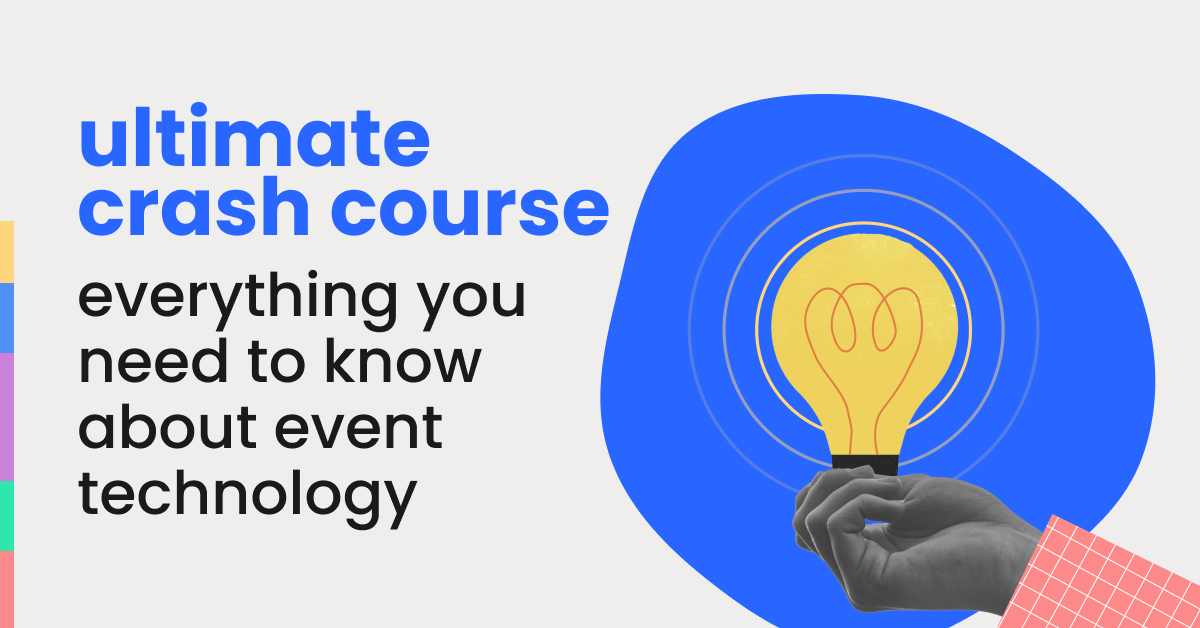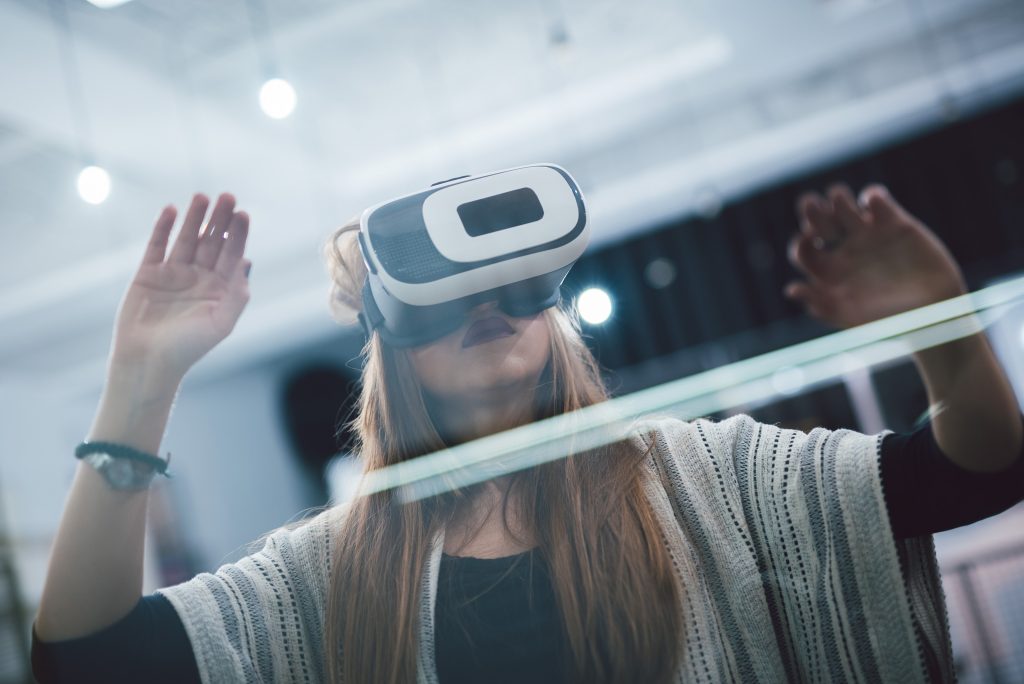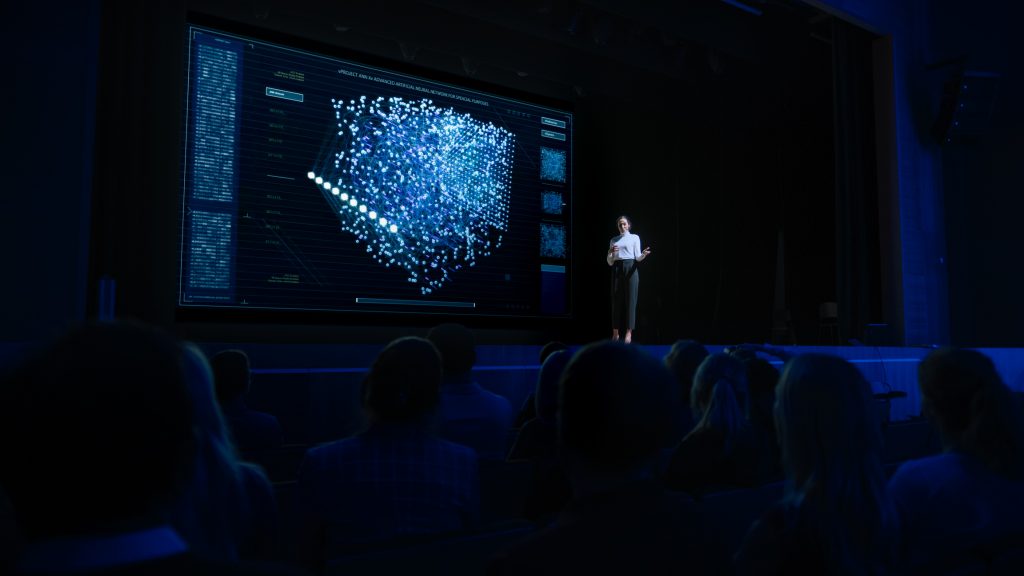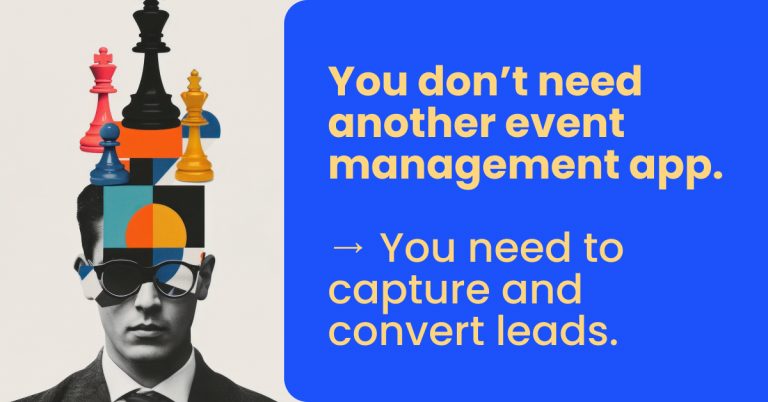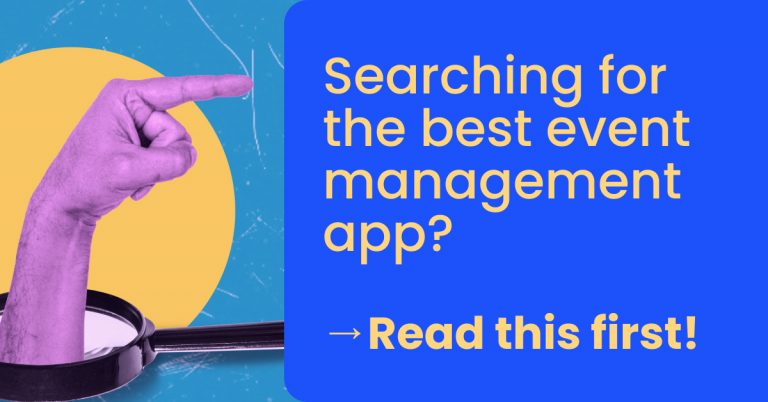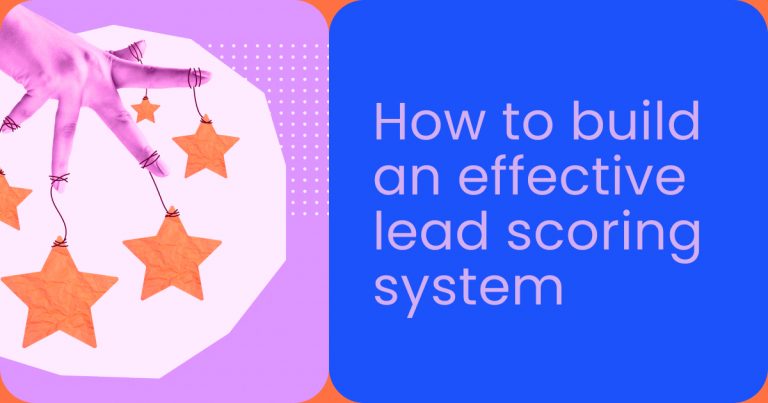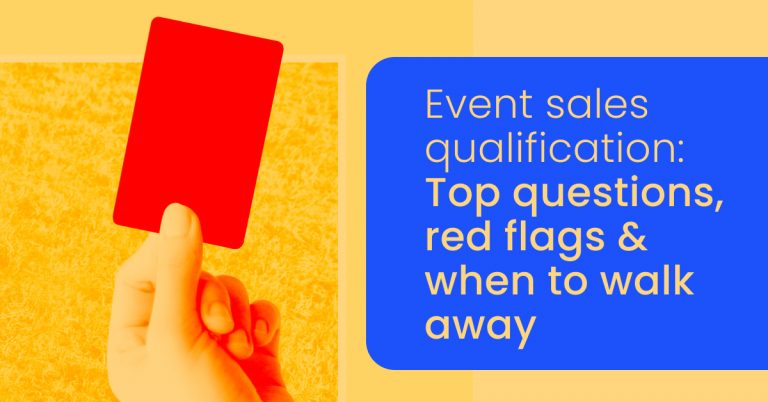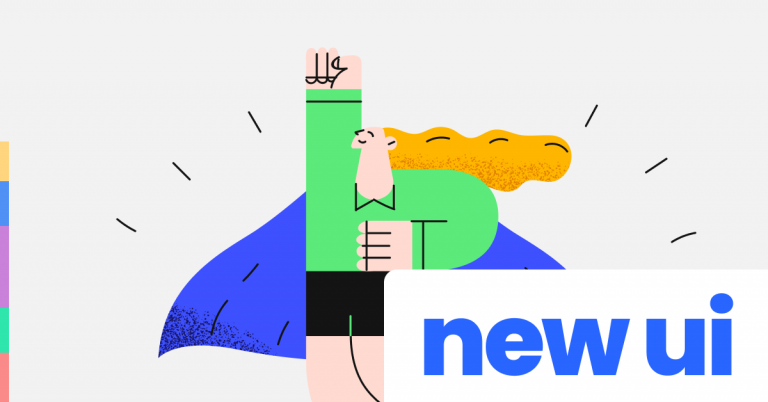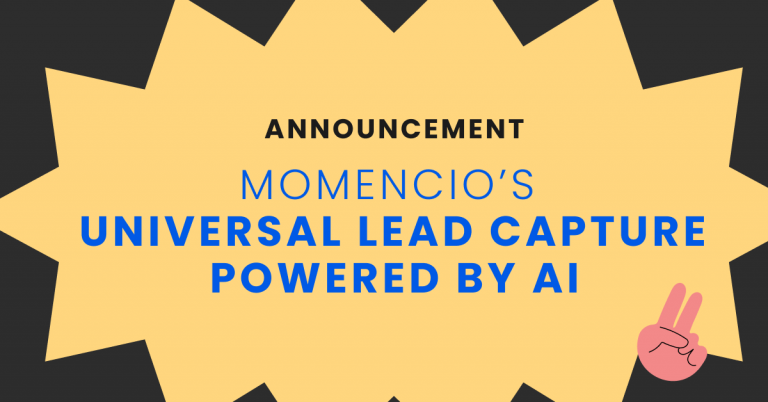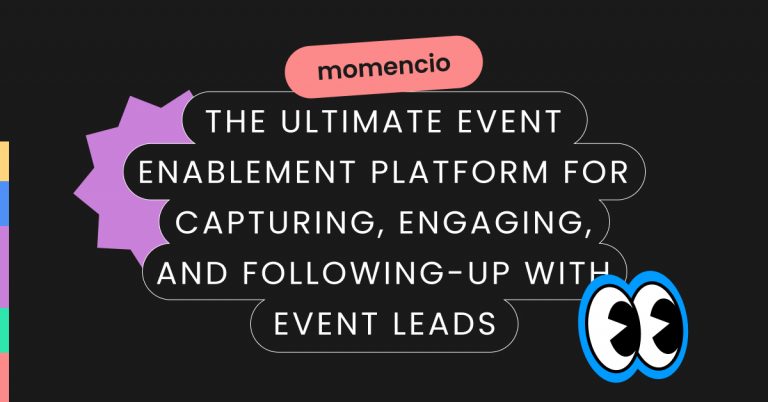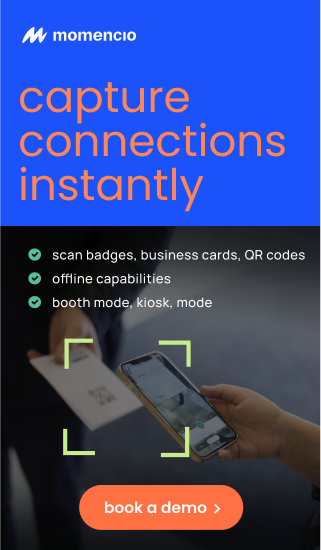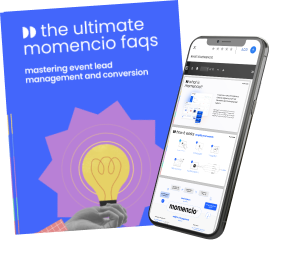Event technology is no longer a luxury in the world of events—it’s a necessity. Whether you’re an exhibitor trying to attract qualified leads, an event planner orchestrating a seamless experience, or an attendee looking for meaningful connections, the right tools can transform how events are experienced, managed, and remembered.
90% of event marketers consider technology to one of the most important element for the success of their events. Exhibitors who integrate advanced event technology, like interactive displays and badge scanning systems, see a 20-30% increase in lead capture rates. For attendees, technology helps personalize the experience, allowing them to connect, learn, and network in ways never possible before. These numbers tell a simple truth: event technology is shaping the future of the industry, driving engagement, and delivering measurable ROI for all stakeholders.
This handy guide is for you if you want to:
- Boost engagement and generate more meaningful leads as an exhibitor.
- Plan, execute, and measure events efficiently as an event planner.
- Enjoy smoother, more rewarding experiences as an attendee.
Throughout this guide, we’ll explore the many facets of event technology: what it is, why it matters, and how to choose and use the right tools. You’ll discover how cutting-edge solutions like QR or badge scanners for lead capture, AI-driven personalization, and gamification can elevate every aspect of an event.
By the end of this guide, you’ll understand not just how to use event technology but also how to master it to meet your specific goals. Events are dynamic, but with the right tools, you can transform complexity into opportunity, turning every interaction into a meaningful connection.
Let’s dive in.
What is event technology?
Event technology refers to the tools and solutions that simplify, enhance, and transform the way events are planned, executed, and experienced. These technologies come in many forms, from mobile apps for attendees to sophisticated analytics platforms for planners, all aimed at making events more efficient, engaging, and impactful.
Imagine an event where attendees navigate the venue using an app, exhibitors capture leads through event badge scans, and planners monitor real-time engagement through a dashboard. This is event technology in action—a seamless integration of software and hardware designed to solve common challenges while opening up new possibilities.
For exhibitors, it’s a way to create dynamic booth experiences, showcase products interactively, and instantly collect attendee information. Tools like badge scanners and customized microsites allow you to capture and nurture leads in ways that feel personal and efficient.
For event planners, it’s about staying in control. Technologies like project management software, hybrid event platforms, and real-time event analytics provide visibility into every aspect of the event, ensuring no detail is overlooked.
For attendees, event technology personalizes the experience. From networking apps that match them with like-minded individuals to gamified experiences that make learning enjoyable, these tools help them get the most value from every moment.
At its core, event technology bridges the gap between complex logistics and human connection. It replaces manual tasks with smart solutions and empowers everyone involved to focus on what really matters—creating memorable, meaningful events.
Examples of event technology for everyone
Event technology isn’t just a buzzword—it’s a toolbox filled with solutions tailored to meet the unique needs of exhibitors, event planners, and attendees. Whether you’re looking to simplify processes, maximize engagement, or create unforgettable experiences, there’s a tool for everyone. Let’s explore some practical examples for each group.
For exhibitors: standing out and capturing leads
Exhibitors often face the challenge of capturing attention in crowded venues. With event technology, they can transform booths into hubs of interaction and engagement:
- Badge and QR code scanners: Gone are the days of collecting business cards manually. Tools like QR/badge scanners or business card scanners enable exhibitors to gather attendee details in seconds. For instance, scanning a badge not only saves contact information but also syncs it with a CRM for instant follow-up.
- Interactive presentations: Imagine being able to tailor a product demo based on the attendee’s needs right on the spot. Presentation tools allow exhibitors to engage visitors dynamically, ensuring the message resonates.
- Gamification elements: Interactive games, quizzes, or virtual reality experiences attract attendees while subtly educating them about a product or service. This combination of entertainment and information keeps visitors engaged and leaves a lasting impression.
For event planners: simplifying event management
Planning an event requires balancing multiple moving parts, and this is where technology shines for planners:
- Event management platforms: These tools streamline registration, agenda creation, and ticketing. They also provide dashboards to track attendance and engagement in real time.
- Hybrid event solutions: Planners managing both virtual and in-person elements can use hybrid platforms to connect all attendees seamlessly. Features like virtual breakout rooms and live polling bridge the gap between digital and physical spaces.
- Analytics and reporting: Real-time event insights let planners track foot traffic, session attendance, and audience engagement. This data helps them make immediate adjustments and measure ROI after the event.
For attendees: making the experience personal
For attendees, event technology enhances their experience by putting information and opportunities at their fingertips:
- Mobile apps: From viewing agendas to navigating venues, mobile apps empower attendees to manage their time effectively. Some even include matchmaking features to connect with like-minded individuals.
- Networking platforms: Attendees can use these tools to schedule meetings, participate in group discussions, or connect one-on-one with other participants before, during, and after the event.
- Gamified experiences: Scavenger hunts, digital leaderboards, or interactive sessions add an element of fun while keeping attendees engaged.
Event technology isn’t one-size-fits-all—it adapts to the unique goals of exhibitors, planners, and attendees. By integrating these tools effectively, events become more than just gatherings; they turn into strategic opportunities for growth, learning, and connection.
Why event technology is important
Event technology is the backbone of modern events, offering tools and strategies that elevate experiences, simplify processes, and generate better results. It’s not just a supporting element—it’s often the difference between an average event and an unforgettable one. Here’s why it matters for exhibitors, planners, and attendees alike.
For exhibitors: driving measurable outcomes
Exhibitors invest significant time and resources into showcasing their brand. Event technology helps ensure that these investments yield tangible results:
- Efficient lead capture: Tools like badge scanners or business card readers eliminate manual data entry, ensuring that leads are collected and organized seamlessly. This efficiency often leads to a higher volume of qualified leads.
- Engagement tracking: Analytics tools let exhibitors see which parts of their booth or presentation are drawing the most attention. Knowing what resonates with attendees helps refine strategies for future events.
- Streamlined follow-up: Instead of waiting days to reconnect with leads, exhibitors can use tools to send personalized follow-up emails or share tailored content like microsites instantly. This keeps the momentum alive and increases conversion rates.
For event planners: simplifying the complex
The role of an event planner often feels like juggling ten balls at once. Event technology helps planners work smarter, not harder:
- Improved efficiency: Tools like project management platforms automate repetitive tasks, from sending reminders to managing RSVPs. This frees up time to focus on the bigger picture.
- Enhanced attendee satisfaction: Real-time updates through event apps, such as schedule changes or session reminders, ensure attendees are always informed. A well-organized event directly translates to happier participants.
- Actionable data: Post-event analytics provide insights into attendance, engagement levels, and session popularity, giving planners a clear picture of what worked and what didn’t.
For attendees: creating value through personalization
Attendees no longer want to be passive participants. Event technology makes their experience more interactive, engaging, and valuable:
- Personalized schedules: With mobile apps, attendees can curate their schedules, ensuring they attend sessions that match their interests and goals.
- Better networking: Features like matchmaking tools or AI-driven suggestions connect attendees with people who share their interests, making networking more meaningful.
- Convenience: From using QR codes for seamless check-ins to accessing digital event materials, attendees save time and effort, allowing them to focus on the event itself.
The bigger picture
The importance of event technology extends beyond individual stakeholders. By integrating advanced tools, events become more sustainable, scalable, and inclusive. For example, hybrid event platforms make it possible to connect audiences from around the globe, while AI tools help planners anticipate challenges and adapt in real time.
In a world where expectations for events continue to rise, event technology is no longer optional. It’s the key to creating experiences that resonate, deliver value, and leave a lasting impact.
How to choose the right event tech
Selecting the right event technology can feel overwhelming with the abundance of tools available today. Each solution claims to offer the best features, but the key lies in finding what aligns with your specific goals, audience, and budget. Whether you’re an exhibitor, an event planner, or an attendee, a strategic approach ensures you choose tools that genuinely enhance your event experience.
1. Define your goals and needs
The first step in choosing event technology is clarity. Understanding what you want to achieve will guide your decision:
- Exhibitors: Are you focused on generating leads, showcasing products interactively, or tracking booth engagement? Tools like badge scanners or interactive presentation software could be your priority.
- Planners: Are you looking to streamline registration, manage hybrid elements, or analyze post-event data? Platforms with robust analytics and scheduling capabilities might be essential.
- Attendees: Are you interested in connecting with others, navigating the event easily, or participating in interactive sessions? Look for apps that enhance networking and engagement.
Start by listing your goals and mapping them to specific features or functions you need from the technology.
2. Evaluate the user experience
No matter how advanced a tool is, it must be easy to use for everyone involved:
- For planners and exhibitors, ensure the platform has a straightforward interface and offers adequate training or customer support.
- For attendees, the tool should be intuitive. A mobile app, for instance, should have clear navigation and quick access to event schedules, networking opportunities, and session content.
Test potential tools with a small team before committing. Hands-on experience helps uncover any usability issues early on.
3. Consider integration capabilities
Events rarely operate in silos, and your technology shouldn’t either. Seamless integration ensures efficiency and consistency:
- CRM integration: For exhibitors and planners, tools that sync with CRM systems like Salesforce or HubSpot help streamline lead management and follow-up.
- Hybrid platform compatibility: For hybrid events, choose platforms that unify in-person and virtual elements, ensuring a cohesive experience for all attendees.
- Existing tools: Evaluate how well the new technology integrates with tools you already use, such as email marketing software or registration platforms.
4. Prioritize scalability and flexibility
Events come in all shapes and sizes, and your tools should adapt to changing needs:
- Exhibitors: If you plan to exhibit at multiple events, choose tools that work across different event types and scales. A portable badge scanner or a cloud-based presentation system can serve various settings.
- Planners: Opt for platforms that handle different event sizes, from intimate gatherings to large-scale conferences, without losing functionality.
- Attendees: Flexible tools like mobile apps with offline functionality can make the experience smooth, even in venues with limited connectivity.
5. Stay within budget without sacrificing quality
Budget considerations often shape the choice of event technology. However, it’s crucial to balance cost-effectiveness with feature quality:
- Request demos and trials to assess whether the tools deliver value before committing.
- Consider tools that bundle multiple features (e.g., lead capture, real-time analytics, and follow-up email systems) to save on using multiple separate tools.
- Remember, the cheapest option isn’t always the best; focus on ROI.
6. Ask for feedback and reviews
Leverage insights from others who’ve used the technology:
- Read user reviews on trusted platforms like G2 or Capterra.
- Ask fellow exhibitors or planners about their experiences.
- Consider feedback from attendees if you’ve used similar tools in the past.
7. Test before you commit
Before rolling out new tools across your event, conduct a trial run:
- Test the badge scanning system during a small internal event.
- Run a mock event on a hybrid platform to identify any technical hiccups.
- Ask a few attendees to explore the mobile app and provide feedback.
By testing early, you’ll gain confidence in your choice and avoid surprises during the actual event.
Choosing the right event technology isn’t just about picking the most advanced tool—it’s about finding solutions that align with your objectives, simplify processes, and deliver value to everyone involved. Done right, it becomes the foundation for a successful event.
How to use event technology to its full potential
Having the best event technology is just the beginning; the real magic lies in how you use it. To maximize its potential, you need to plan strategically, integrate seamlessly, and make it work for everyone involved. Whether you’re an exhibitor, event planner, or attendee, the following strategies will help you leverage event technology to its fullest.
For exhibitors: creating an interactive and engaging booth
Exhibitors often face the challenge of standing out in a crowded venue. Event technology can make your booth not only eye-catching but also effective in achieving your goals.
- Maximize lead capture tools
Use badge scanners or QR code readers to collect attendee information quickly and accurately. When combined with real-time data enrichment, these tools ensure that every captured lead comes with detailed insights, making follow-ups more personal and targeted. - Enhance engagement with presentations
Interactive presentation tools enable you to customize your message based on an attendee’s interests. Whether it’s a product demo or an in-depth case study, tailoring the experience creates a stronger connection. - Integrate gamification
Adding gamification elements, such as virtual spin-the-wheel contests or digital scavenger hunts, makes your booth memorable. These experiences entertain visitors while driving them to learn more about your brand or product. - Leverage real-time analytics
By using technology to track which parts of your booth generate the most engagement, you can adjust your strategy on the fly to focus on what works best.
For event planners: ensuring seamless execution
As the orchestrators of the event, planners have the most to gain from utilizing event technology. When used effectively, these tools streamline workflows and elevate the attendee experience.
- Streamline event management platforms
Use a central dashboard to oversee registrations, monitor session attendance, and send updates to attendees. This simplifies complex logistics and ensures everything runs smoothly. - Enable real-time communication
Mobile apps and SMS alerts can instantly notify attendees of schedule changes, announcements, or networking opportunities. This eliminates confusion and keeps participants informed. - Monitor attendee engagement live
Tools like heatmaps or session attendance trackers provide a live view of what’s resonating with your audience. If certain sessions are less attended, you can promote them in real time or adjust room allocations to optimize space. - Post-event tools for better planning
Use technology to gather feedback through surveys and analyze attendance data. This information helps refine future events and improve ROI.
For attendees: making the most of every opportunity
Event technology empowers attendees to navigate the event more effectively and connect with people and opportunities that matter to them.
- Create personalized schedules
Use mobile event apps to customize your schedule based on your interests. These apps often allow you to filter sessions, speakers, or exhibitors that align with your goals. - Engage in networking
Networking tools and matchmaking algorithms help you identify like-minded individuals and schedule one-on-one meetings. Instead of wandering aimlessly, you can make meaningful connections efficiently. - Participate actively in gamified experiences
If the event offers games or challenges, dive in. These not only make the experience enjoyable but also open doors to unexpected interactions and prizes. - Use digital event materials
Download presentations, session handouts, or exhibitor brochures directly from the event app. This ensures you have all the resources you need without carrying piles of paper.
Key tips for everyone
- Plan ahead: Familiarize yourself with the technology before the event. Planners should test tools, exhibitors should run mock demonstrations, and attendees should explore event apps.
- Provide training: Planners and exhibitors should ensure their teams are well-versed in using the tools to avoid hiccups during the event.
- Stay adaptable: Technology is a tool, not a rigid solution. Be prepared to adapt and troubleshoot as needed to make the most of it.
When used thoughtfully, event technology doesn’t just enhance the event experience—it transforms it. By focusing on how it can serve your specific needs, you’ll unlock its full potential and create events that truly stand out.
Event technology trends to watch in 2025
Event technology is constantly evolving, and staying ahead of the curve means being prepared for emerging trends that redefine how events are planned and experienced. In 2025, the focus is on creating smarter, more inclusive, and more immersive event experiences for exhibitors, planners, and attendees alike.
1. Artificial intelligence for personalization and efficiency
Artificial intelligence (AI) has transformed how events are run, and its impact will only grow in 2024.
- For exhibitors: AI-driven lead scoring helps prioritize high-quality leads in real time. Tools can analyze attendee behavior—such as time spent at a booth or interest in specific products—and suggest personalized follow-up actions.
- For planners: AI-powered analytics predict attendance patterns and recommend ways to optimize room layouts, speaker schedules, or catering needs. These insights reduce waste and improve efficiency.
- For attendees: AI-based matchmaking connects participants with the most relevant peers, exhibitors, or sessions based on their profiles and goals, enhancing the networking experience.
2. Immersive experiences with AR and VR
Augmented reality (AR) and virtual reality (VR) are redefining event experiences by blending physical and digital elements.
- For exhibitors: AR lets attendees visualize products in a virtual space, such as viewing a 3D model of a machine at a trade show. VR immerses participants in branded worlds, creating memorable interactions.
- For planners: Virtual walkthroughs of venues help with planning and logistics, saving time and reducing errors.
- For attendees: Whether it’s exploring a virtual exhibit or participating in an interactive training session, AR and VR offer unique ways to engage with content.
3. Sustainability-focused technology
Sustainability is no longer optional. Event technology is helping planners, exhibitors, and attendees reduce their carbon footprint.
- For planners: Tools for digital ticketing, paperless registration, and event apps eliminate unnecessary materials. Carbon footprint calculators and tools for sustainable vendor sourcing are becoming more prevalent.
- For exhibitors: Portable digital displays replace printed signage, while gamification can encourage attendees to participate in eco-friendly actions, like recycling.
- For attendees: Digital swag and QR codes for accessing resources reduce waste and support sustainable practices.
4. Hybrid event platforms 2.0
The hybrid model continues to evolve, offering improved tools to connect in-person and virtual audiences seamlessly.
- For planners: Hybrid platforms now include features like simultaneous translations, AI-driven audience engagement tracking, and virtual networking lounges.
- For exhibitors: Virtual booths, interactive presentations, and live chats allow exhibitors to connect with virtual attendees just as effectively as in-person ones.
- For attendees: On-demand sessions and networking tools enable participants to access content and connect with others at their convenience.
5. Real-time engagement tools
Engagement is at the heart of every successful event, and technology is making it more dynamic than ever.
- Live polling and Q&A: These tools allow planners and exhibitors to gauge audience interest and tailor content in real time.
- Gamified leaderboards: For both exhibitors and planners, leaderboards encourage friendly competition, whether it’s tracking booth visits or rewarding attendees for participating in sessions.
- Interactive presentations: Tools that allow attendees to ask questions or vote on topics during a session keep them involved and attentive.
6. Advanced analytics and insights
The demand for actionable insights will continue to grow. Planners, exhibitors, and attendees all benefit from smarter data:
- For planners: Predictive analytics help optimize event scheduling and attendance patterns. Post-event dashboards summarize performance metrics like engagement, foot traffic, and ROI.
- For exhibitors: Real-time heatmaps show booth activity levels, while lead conversion tracking offers insights into sales outcomes.
- For attendees: Personalized recommendations based on their engagement history guide them to relevant sessions and networking opportunities.
7. Enhanced security and privacy tools
As events become more tech-driven, protecting attendee data is paramount.
- For planners: Secure registration systems and encrypted communication platforms protect sensitive information.
- For exhibitors: Tools that anonymize lead data ensure compliance with privacy laws like GDPR.
- For attendees: Event apps now come with robust privacy settings, allowing users to control what information is shared and with whom.
2024 is poised to be a transformative year for event technology. From AI and VR to sustainability and security, these trends are paving the way for smarter, greener, and more engaging events. By understanding and embracing these innovations, you’ll be better equipped to create experiences that stand out and deliver lasting impact.
Common challenges with event technology and how to fix them
Event technology holds incredible potential, but like any tool, its effectiveness depends on how well it is implemented and used. From technical hiccups to user resistance, here are some common challenges faced by exhibitors, planners, and attendees, along with practical solutions to overcome them.
1. Integration issues
One of the most significant hurdles is ensuring that different technologies work together seamlessly.
- The challenge: Exhibitors often struggle to sync lead capture tools with CRMs. Planners face difficulties connecting ticketing platforms with analytics software.
- The solution: Choose tools with open APIs or pre-built integrations that allow them to connect easily with existing systems. For planners, hybrid platforms that unify digital and physical elements can simplify workflows. Testing systems before the event is critical to identifying and fixing compatibility issues early.
2. Complexity and steep learning curves
Advanced event tools often come with a host of features, but their complexity can overwhelm users.
- The challenge: Planners may find it time-consuming to train teams on new platforms. Exhibitors might not fully utilize features like interactive presentations or gamification. Attendees could avoid apps that seem too complicated.
- The solution: Opt for user-friendly platforms that offer robust support, such as tutorials, demos, or 24/7 assistance. Exhibitors and planners should schedule training sessions for staff to ensure confidence in using the technology. Simplifying attendee-facing tools, such as apps with clear navigation and minimal steps, improves adoption.
3. Limited budget and resource constraints
Technology often comes at a cost, and smaller events may struggle to justify the expense.
- The challenge: Balancing high-quality tech with limited budgets can lead to compromises that hinder event success.
- The solution: Focus on tools that deliver the highest ROI, such as multi-feature platforms that handle registration, engagement, and analytics. Look for free or affordable options for smaller needs, such as gamification add-ons or email follow-up tools. Exhibitors can use scalable solutions like badge scanners that work across multiple events, spreading the cost.
4. Attendee reluctance to adopt technology
Not all attendees are comfortable using new technologies, which can limit the overall impact of your event tech.
- The challenge: Some attendees may avoid event apps or digital interactions, preferring traditional methods.
- The solution: Encourage early adoption by offering tutorials or demo videos before the event. Provide alternatives, like kiosks for check-ins or printed schedules for those who prefer offline options. Highlight the benefits of using technology, such as faster networking or access to exclusive content, to motivate participation.
5. Connectivity issues
Poor internet connections can disrupt the performance of event tools, especially in venues with high traffic.
- The challenge: Real-time tools like audience polling, live streaming, or virtual platforms may fail without stable connectivity.
- The solution: Work with venues to ensure strong Wi-Fi or provide backup options like mobile hotspots. For hybrid events, test internet speeds for both in-person and virtual audiences. Offline-capable tools can keep attendees and exhibitors productive even without internet access.
6. Lack of actionable insights from data
While technology generates vast amounts of data, turning it into actionable insights can be challenging.
- The challenge: Planners and exhibitors may feel overwhelmed by reports or unsure of which metrics to focus on.
- The solution: Use platforms with intuitive dashboards that highlight key performance indicators (KPIs) relevant to your goals. For planners, engagement heatmaps or session popularity rankings provide immediate clarity. Exhibitors should focus on metrics like booth visits, lead quality, and conversion rates.
7. Over-reliance on technology
While technology can enhance events, relying on it too heavily can backfire, especially if something goes wrong.
- The challenge: A technical failure can lead to chaos if backup plans are not in place.
- The solution: Always have contingency plans. For example, if a badge scanner malfunctions, ensure manual forms are available. If a virtual platform experiences downtime, provide recorded sessions or alternative access links.
8. Privacy and security concerns
As events become more data-driven, protecting attendee information is more important than ever.
- The challenge: Breaches or misuse of data can damage trust and potentially violate regulations like GDPR.
- The solution: Use platforms with strong encryption and data privacy policies. Clearly communicate to attendees how their data will be used, and give them control over their privacy settings. Regular audits of tech systems ensure compliance and security.
Event technology is powerful, but like any tool, its success depends on thoughtful implementation and preparation. By anticipating challenges and addressing them proactively, you can create a smooth, impactful experience for everyone involved.
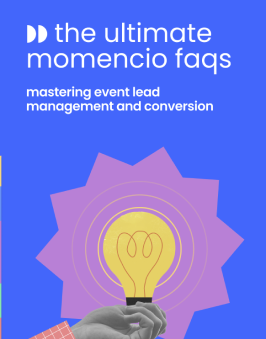
How to measure success with event technology
The true value of event technology isn’t just in its implementation—it’s in the results it helps deliver. For exhibitors, event planners, and attendees, measuring the success of these tools provides insights that drive better decisions for future events. But how do you quantify success when there are so many factors at play? The answer lies in understanding key metrics and using the right tools to evaluate performance.
1. Define your success metrics
Start by identifying what success looks like for your role:
- Exhibitors: Success could mean the number of leads captured, the quality of those leads, or the engagement level at your booth.
- Planners: Metrics like attendee satisfaction, session attendance, and overall event ROI offer a clear picture of how well the event performed.
- Attendees: Value might be measured in the connections made, the quality of content consumed, or how easy it was to navigate the event.
2. Use event technology to track data
Modern event technology is designed to simplify data collection and analysis. Here’s how to leverage it effectively:
- Lead capture tools: Badge scanners, QR code readers, and business card scanners don’t just collect data—they sync it with CRMs, providing immediate insights into lead quality and engagement.
- Engagement analytics: Tools like heatmaps show which parts of an event space drew the most attention, while session trackers highlight the popularity of different presentations.
- Post-event surveys: Use digital surveys to capture attendee feedback on the content, venue, and overall experience.
3. Analyze ROI for exhibitors and planners
Both exhibitors and planners need to calculate ROI to understand the event’s impact:
- Exhibitors: Measure the cost per lead by dividing the total event cost by the number of qualified leads captured. Use analytics to see which interactions (e.g., gamification activities, demos) drove the highest engagement.
- Planners: Compare the event’s expenses to the revenue it generated through ticket sales, sponsorships, or leads. Use tools to track session attendance and content downloads to identify what resonated most with your audience.
4. Evaluate engagement metrics
Engagement is a vital indicator of success for everyone involved:
- Attendee participation: Metrics like app downloads, poll responses, and social media mentions offer insight into attendee involvement.
- Networking interactions: Platforms that track meetings, chat activity, or matchmaking success provide measurable data on how well attendees connected.
- Content engagement: For virtual and hybrid events, metrics like video watch times, session attendance rates, and Q&A participation can gauge interest and satisfaction.
5. Benchmark against previous events
Success doesn’t happen in isolation; it’s important to compare results to past performance:
- For planners: Look at attendance growth, sponsorship interest, or improvements in attendee satisfaction year over year.
- For exhibitors: Compare lead quality and engagement metrics across different events to refine booth strategies.
- For attendees: Reflect on how the event met your professional or personal goals compared to previous ones.
6. Use dashboards for visualization
Most event technology tools come with built-in dashboards that make it easy to visualize success metrics:
- Real-time tracking: Dashboards allow you to monitor engagement and activity as the event unfolds, enabling quick adjustments.
- Post-event reports: Comprehensive analytics provide an overview of what worked and what didn’t, highlighting areas for improvement.
7. Translate data into action
Numbers only matter when they lead to action. Use insights from event technology to refine future strategies:
- Exhibitors: Focus on the activities that drove the highest engagement and improve underperforming areas. For instance, if gamification attracted the most leads, prioritize it in future events.
- Planners: Use data to reallocate resources. If certain sessions were more popular than expected, consider giving them a bigger platform next time.
- Attendees: Share your feedback to influence future event design, and use networking tools to maintain connections post-event.
8. Balance qualitative and quantitative insights
While data is essential, don’t overlook qualitative feedback:
- Surveys and interviews: Ask attendees, sponsors, and staff for their perspectives. Their insights can reveal blind spots or unexpected successes that data alone might miss.
- Social media sentiment: Monitor how attendees are talking about the event online to gauge the overall mood and impact.
Measuring success with event technology isn’t about focusing on a single number. It’s about gathering a complete picture that includes engagement, satisfaction, and ROI, then using those insights to create even better experiences.
How to create a seamless attendee journey using event technology
Imagine walking into an event where every step feels effortless—from the moment you register to the connections you make afterward. That’s the power of event technology when it’s used thoughtfully. Here’s how you can shape a flawless attendee journey:
Step 1: Begin with an easy start
The attendee journey starts at registration. Make it so simple they don’t even need to think.
- Offer intuitive registration platforms that allow attendees to choose sessions, dietary preferences, or even pre-schedule meetings.
- Use QR codes or digital badges for fast check-ins. The goal? No long lines or confusing entry points.
Step 2: Tailor the experience
Attendees want events to feel like they were designed just for them. Event technology can make that happen.
- Use mobile apps to offer personalized schedules. When they choose a session, it appears in their agenda automatically.
- Send smart notifications that nudge them towards sessions or activities they care about.
Step 3: Keep them engaged on-site
Once they arrive, the focus shifts to creating meaningful interactions.
- Add live polls and Q&A tools during presentations to let attendees shape the conversation.
- Use networking platforms that match them with like-minded people, simplifying the awkwardness of introductions.
- Gamify the experience with interactive challenges—because who doesn’t like winning prizes while learning?
Step 4: Give them resources that matter
Every attendee values takeaway material, whether it’s a new idea, a solution, or a contact.
- Host resources like session handouts or exhibitor brochures in a centralized event app.
- Allow exhibitors to share microsites filled with tailored content for deeper dives.
Step 5: Help them feel heard
Communication is a two-way street, even at events.
- Use live feedback forms so attendees can rate sessions or share concerns instantly.
- Deploy chatbots to answer common questions—fast and fuss-free.
Step 6: Don’t let the connection fade
After the event ends, the journey isn’t over. Use technology to keep the momentum going.
- Automate thank-you emails that recap the highlights and offer links to session recordings.
- Create post-event surveys to learn what they loved and what could be better next time.
Bonus tip: Bridge the hybrid gap
For hybrid events, syncing the virtual and physical experience is critical.
- Use hybrid event platforms to ensure everyone—from remote attendees to those on-site—can interact seamlessly.
- Encourage cross-platform participation by integrating live chat, Q&A, and networking for both audiences.
Attendees remember events that make them feel valued, connected, and at ease. With the right tools, you’re not just hosting an event—you’re creating a journey that attendees will want to relive.
Post-event strategies powered by technology
The days following an event are as crucial as the event itself. This is when connections are deepened, leads are nurtured, and insights are extracted. With event technology, post-event follow-up becomes not just efficient but impactful. Here’s how to make the most of it.
1. Personalize your follow-ups
Generic follow-up emails are a thing of the past. Event technology allows you to craft highly personalized messages that resonate.
- Use attendee data collected during the event to tailor emails. For example:
- “We noticed you attended the [AI in Marketing] session. Here’s a whitepaper you might enjoy.”
- “Thank you for visiting our booth. Here’s a quick recap of our solutions and next steps.”
- Leverage automation tools to send these emails at scale while maintaining a personal touch.
2. Share event content effectively
Attendees often miss sessions or want to revisit key moments. Providing on-demand content keeps your event alive in their minds.
- Use your event platform to share:
- Recorded sessions.
- Presentation slides.
- Exclusive Q&A transcripts.
- Ensure content is easily accessible, perhaps through microsites or attendee portals, and make it shareable to expand your event’s reach.
3. Analyze your event data
The data collected during an event is a goldmine of insights—if used correctly.
- For exhibitors:
- Identify the most engaged leads by reviewing booth traffic, gamification participation, or presentation downloads.
- Segment leads based on behavior to prioritize follow-ups.
- For planners:
- Analyze session attendance and feedback to determine what worked and what didn’t.
- Use heatmaps and survey responses to refine the attendee journey for future events.
4. Keep the conversation going
The event might be over, but the dialogue doesn’t have to stop.
- Use social media platforms to share highlights, such as event photos, attendee testimonials, or standout moments.
- Start discussions around event themes to sustain engagement.
- For exhibitors, engage attendees with polls or invite them to a webinar that dives deeper into your offerings.
5. Plan future touchpoints
Post-event isn’t just about wrapping up—it’s about creating a pipeline of future opportunities.
- For attendees, provide options to:
- Pre-register for upcoming events.
- Subscribe to newsletters or industry updates.
- For exhibitors, create a drip campaign that nurtures leads over time with valuable content and clear calls to action.
6. Gather and act on feedback
Feedback is essential for growth. Event technology simplifies the collection and application of this data.
- Use surveys to ask attendees about:
- Session quality.
- Networking opportunities.
- Overall satisfaction.
- Analyze trends to address weak points and build on successes for the next event.
7. Demonstrate ROI to stakeholders
Post-event reports aren’t just for planners—they’re vital for exhibitors and sponsors, too.
- Use analytics tools to create clear, visual reports showing:
- Total attendance and session participation.
- Lead quality and conversion potential.
- Social media engagement metrics.
- These reports help justify budgets and secure buy-in for future events.
8. Reinforce connections through follow-up events
One of the best ways to keep momentum is by planning smaller, related events.
- Host webinars or roundtables that expand on event themes.
- Invite key attendees to exclusive follow-up discussions.
Post-event strategies powered by technology ensure your event doesn’t end when the lights go out. They transform fleeting moments into long-term opportunities, keeping your brand at the forefront of attendees’ minds and paving the way for even greater success next time.
Checklist: what to do before, during, and after an event using technology
A well-planned event doesn’t happen by accident. It requires meticulous preparation, smooth execution, and thoughtful follow-up. Event technology can streamline every phase, ensuring nothing is left to chance. Here’s a comprehensive checklist for using technology before, during, and after your event.
Before the event |
During the event |
After the event |
Choose the right tools1. Select platforms for registration, lead capture, and analytics. 2. Ensure tools integrate seamlessly with CRMs and other systems. 3. Test every tool to confirm functionality and compatibility. |
Optimize attendee engagement1. Use push notifications to remind attendees of upcoming sessions or networking opportunities. 2. Offer live polls, Q&A tools, and gamified activities to keep attendees engaged. 3. Encourage exhibitors to use interactive presentations and gamified booth experiences. |
Follow up with personalized content1. Send tailored emails based on attendee preferences and actions during the event. 2. Share session recordings, slides, or exhibitor microsites. |
Set up registration and promotion1. Launch an intuitive registration system that collects attendee preferences. 2. Use email marketing platforms and social media scheduling tools to promote the event. 3. Create a mobile event app and encourage early downloads. |
Monitor real-time analytics1. Track session attendance and engagement through dashboards. 2. Identify and address low-participation areas immediately. |
Analyze event performance1. Review metrics like attendance, engagement levels, and lead quality. 2. Generate detailed reports for stakeholders and sponsors. |
Prepare your content and logistics1. Upload presentations, session materials, and digital brochures to the event platform. 2. Test virtual and hybrid platforms for sound, video, and network stability. 3. Equip exhibitors with badge scanners or QR code readers for lead capture. |
Ensure smooth operations1. Use chatbots to assist attendees with questions about schedules, locations, or tools. 2. Deploy backup internet solutions to maintain connectivity for virtual participants. |
Keep attendees engaged1. Use surveys to collect feedback and insights. 2. Invite attendees to upcoming events or webinars. Refine your strategies1. Evaluate what worked and what didn’t using post-event data. 2. Update your processes to enhance future events. |
This checklist ensures every phase of your event is optimized for success, leaving nothing to chance and making the most of the tools at your disposal.
Tips for staying updated on the latest event technology trends
The event technology landscape evolves rapidly, with new tools and techniques emerging regularly. Staying ahead of these trends is essential for exhibitors, planners, and attendees who want to maximize their event experiences. Here’s how you can stay informed and leverage the latest innovations.
1. Follow industry blogs and publications
Event technology blogs and websites are invaluable resources for staying updated.
- Bookmark trusted sources like Skift and momencio’s blog.
- Subscribe to newsletters that provide regular updates on event tech trends, tools, and case studies.
2. Join online communities
Networking with like-minded professionals helps you stay in the loop about emerging technologies.
- Participate in forums or LinkedIn groups focused on event planning and technology.
- Engage in discussions to exchange experiences and recommendations about tools and platforms.
3. Attend technology-focused webinars and conferences
Many event tech companies and thought leaders host webinars and sessions to showcase their latest tools.
- Look for virtual conferences or hybrid events dedicated to event technology.
- Use these opportunities to explore live demos and interact with product developers.
4. Test new tools regularly
Hands-on experience is one of the best ways to understand emerging event technologies.
- Request demos or trials from vendors to assess how new tools fit into your existing workflows.
- Experiment with features like AI-lead enrichment, predictive analytics, augmented reality, or hybrid platform integrations.
5. Follow tech innovators on social media
Stay connected to the thought leaders and innovators driving event tech forward.
- Follow companies like momencio for updates on their latest developments.
- Engage with influencers and industry experts who share insights on trends and best practices.
6. Explore case studies and success stories
Learning how others have successfully implemented event technology can inspire your strategy.
- Read about real-world applications of tools like badge scanners, gamification, or hybrid platforms.
- Understand the challenges others faced and how they solved them using technology.
7. Subscribe to trend reports and research studies
Detailed reports offer a broader perspective on where the industry is headed.
- Look for annual event trend reports from platforms like event marketer.
- These insights often include data on emerging technologies, adoption rates, and industry forecasts.
8. Collaborate with tech-savvy vendors
Vendors specializing in event technology often act as your partners in staying updated.
- Regularly connect with your technology providers to learn about updates or new releases.
- Attend training sessions or user conferences they organize to deepen your knowledge.
9. Stay curious and experiment
The key to staying ahead is maintaining an open mind and a willingness to explore.
- Set aside time to explore new tools or trends each quarter.
- Be ready to adapt and implement technologies that align with your goals.
By actively seeking out information, engaging with the event technology community, and experimenting with new tools, you can stay ahead of the curve. This approach ensures you’ll always be prepared to leverage the latest innovations to elevate your events.
Key takeaways
Event technology is no longer an optional add-on; it’s a cornerstone of successful events for exhibitors, planners, and attendees alike. Throughout this guide, we’ve explored how technology can streamline operations, enhance engagement, and deliver measurable results. Here are the key takeaways to remember as you integrate event technology into your strategy:
For exhibitors:
- Event technology like badge scanners, QR codes, and interactive presentations can transform your booth into a lead-generation powerhouse.
- Use analytics to track visitor engagement and prioritize follow-ups for high-potential leads.
- Gamify your booth experience to draw attention and leave a lasting impression.
For event planners:
- Streamline your planning process with tools that manage registrations, monitor real-time engagement, and analyze post-event performance.
- Leverage hybrid event platforms to connect in-person and virtual audiences seamlessly.
- Use data-driven insights to refine future events and demonstrate ROI to stakeholders.
For attendees:
- Personalize your experience with mobile apps that offer tailored schedules, networking tools, and easy access to event resources.
- Participate actively in polls, Q&As, and gamified activities to make the most of the event.
- Provide feedback through post-event surveys to shape better experiences in the future.
Event technology is as much about strategy as it is about tools. To unlock its full potential:
- Define clear goals before choosing and implementing technology.
- Use tools to create a seamless attendee journey, from registration to post-event follow-up.
- Stay updated on emerging trends to continuously improve your event strategy.
Finally, remember that technology is a means to an end—it’s there to simplify complexity, enhance connections, and help you create memorable, impactful events. By embracing these tools thoughtfully and strategically, you’ll stay ahead in an ever-evolving industry.
FAQs
- How can I capture and manage leads effectively at events?
- Capturing and managing leads efficiently requires tools that eliminate manual processes. momencio enables exhibitors to use QR or badge scanners to collect attendee information instantly. The platform integrates this data with CRMs, allowing you to track, nurture, and prioritize leads effortlessly.
- What’s the best way to engage attendees at my booth?
- Interactive tools are key. With features like personalized presentations and gamified experiences, momencio helps exhibitors create dynamic, tailored interactions that resonate with visitors. This not only attracts attendees but also ensures a lasting impression.
- How do I ensure personalized follow-ups after an event?
- Personalization depends on understanding attendee interests. momencio automatically syncs captured leads with notes and preferences, enabling you to send follow-up emails and microsites tailored to each lead’s specific interests. This makes follow-ups timely, relevant, and impactful.
- What tools can I use to track attendee engagement during and after an event?
- Real-time tracking tools provide insights into attendee behavior. momencio offers dashboards that show booth visits, content interactions, and engagement metrics. These insights allow exhibitors and planners to measure what worked and adjust strategies effectively.
- How can I maximize ROI from my event leads?
- To maximize ROI, focus on turning leads into sales. With features like lead scoring, instant follow-ups, and personalized microsites, momencio streamlines the sales journey, ensuring every lead receives the attention it deserves to drive conversions.
- What role does technology play in hybrid or virtual events?
- Technology ensures seamless engagement for both in-person and virtual attendees. momencio’s capabilities, such as digital presentations, virtual booth experiences, and hybrid-compatible lead capture, allow you to connect meaningfully with all participants, no matter where they are.
- How can I measure the success of my event and improve future strategies?
- Success lies in the data. Platforms like momencio provide comprehensive analytics, from lead quality to post-event conversions. These insights help you assess what worked, what didn’t, and how to optimize your approach for future events.
